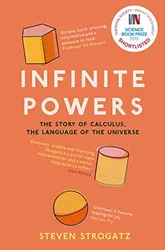Before reading this book, I thought of calculus as that branch of mathematics that has to do with differentiation and integration. The mathematics of calculus was one of the things that I found particularly difficult while studying physics at university. I never really understood what was going on with all those dx symbols and integral signs, especially when it came to trigonometric functions. While I learned some of the methods, I don’t think I ever really understood the principles behind them. I think this book might have helped if it had been written then; alas it was published more than twenty years too late for me!
The book explains why calculus is fundamental to science, as it’s the mathematical tool we use most when describing the laws of the universe, from Newton’s laws of motion, to Maxwell’s equations for electromagnetism, to the quantum wave function. The book also explains that the fundamental basis for calculus is the idea of using infinitesimals (very small numbers) to break problems down, and infinity to build them back up again to get an answer. For example, to calculate the area under a curve you can think of that area as being made up of an infinite number of infinitesimally small rectangles. Since the areas of rectangles are easy to calculate, this makes the problem easier to solve.
The book goes back to Archimedes in Ancient Greece to explain how this way of thinking was developed. Before reading this book I had the idea that Isaac Newton had invented calculus, and I knew about Leibniz too, who came up with it at the same time. This book makes the case that Archimedes, many centuries earlier, was inventing and using some of the principles of calculus to calculate the areas of geometric shapes. Other people prior to Newton, such as Galileo, Fermat and Descartes, were also using and developing calculus principles.
There is mathematics in this book, almost inevitably for a book on calculus. If you’ve done some high school algebra it probably won’t phase you too much. One of the strengths of this book is that it builds up to the equations really slowly and smoothly, allowing you to understand the background and the thinking involved before an equation appears. And in a lot of cases, an equation isn’t needed at all. In fact, the explanations are so good that sometimes I found myself wishing there was more maths, and that things had been taken a little further. This book won’t teach you calculus, but it does a great job of laying a solid foundation of understanding for the fundamental concepts involved.
The great thing about the Archimedes examples is that they can be followed from start to finish by logical steps, with a result produced at the end. As the book progresses, the examples become more complex, and I suspect the author felt that the maths would become too complicated to show in its entirety. For a popular science book like this that was probably the right decision. The detailed mathematics of how a CT (computed tomography) scanner works, and how an image is produced from multiple x-rays, is probably several papers worth of equations.
I came away from this book a little bit confused about how the mathematics of integration actually worked. The book talks about the “backward problem”: it’s easy to go in one direction, splitting the problem up into a large number of smaller problems, but hard to go in the other direction of putting the answer back together again. The book talks about how Newton and Leibniz solved this problem with the fundamental theorem, and how this has led to integrals now being solvable by high school students. Personally I could have done with some high-school level examples to clarify exactly how the work of Newton and Leibniz applies to these sorts of problems.
Overall though, I think this is an excellent book. It’s of general interest if you are interested in science, as calculus underpins so much of science. I think it would also be a really great book to read if you are beginning to encounter calculus in school, and want a bit more background. Even if you’ve done quite a bit of calculus already, but haven’t quite grasped the reasons why it’s so useful, I think it’s worth reading.
